
Only Known Facts About Childhood of Jesus Revealed
The following information concerning the birth and childhood of Jesus are all the known verifiable facts available. This study includes Scripture commentary and several common sense deductions. Anything one has heard or read about Jesus that is not found in this Paper is fiction. The vast majority of information contained in this Paper is taken from the Gospels. Additional facts are supplied by past and recent archaeological discoveries along with verified writings by early Church Fathers in the first and second centuries.
SUMMARY
The two major sources of reliable information concerning the Childhood of Christ are found in the Gospels and the writings of the early Church Fathers. Because the Gospels do not mention the complete destruction of Jerusalem in 70 AD, many Bible scholars now believe they were written before this event. The Gospels of Matthew and John were written by two of Jesus' actual disciples. The Gospels of Mark and Luke were written by two devoted followers although not actual member of the original twelve disciples. The writings of the early Church Fathers {Apostolic Fathers} are from the years 95 AD to 150 AD. A third source of information are conclusions drawn from archeological finds that show the day to day activities of the average working class Judean. Together, these three sources paint an accurate picture of the times and customs Jesus would have experienced as a child and during His early adult years.
The bulk of misinformation about Jesus' early childhood comes from five fictional biographies. These writings were created by unknown authors who attempted to satisfy the curiosity of followers and earn a living. These non conical and at times heretical works were given new life when, in the middle second and third centuries, parts of these stories were included in Catholic Church doctrine to help support the deification of Mary and later as part of a membership campaign drive as ordered by Emperor Constantine. These doctorial additions were rejected by many Church scholars at the time. And, they were later cited as the foundational reasons for a great Church schism called the Reformation {October 1517}. It was at this time that conservative Christians protested these unauthentic fictional stories being allowed to create cannons of beliefs and customs that were then used at times to override Gospel truths. Many priests left the Universal {Catholic} Church to create various dominations collectively know as the Protestant Church. The word Protestant comes from the word protest as in Protest-ant.
While these false works were referred to in second and third century writings, complete copies were found in 1945 among the Dead Sea Scrolls. Over the past eighty years, exhaustive studies have been conducted on these works by the world's leading Bible scholars. All have concluded that they are complete works of fiction created by authors who are writing storylines specifically designed to take advantage of developing unscriptural sectarian beliefs. These beliefs include Mary as a perpetual virgin, Mary as the Mother of God, Mary as Queen of Heaven, Mary as intermediary between a believers prayers and Christ, the assumption of Mary physically into Heaven at her death, Mary seated at the right hand of Christ and the Apostles as intermediaries between a believer’s prayers and Christ. Additionally, some of these writings were created to authenticate the practices of a priest’s authority to forgive sin, amounts of penitence necessary to receive forgiveness of sin, etc. These writing were extremely popular among the faithful and were sold to devout Christians to support unscriptural doctrine and for profit.
There is no reference in the New Testament that Jesus married. There is no reference that He left behind any children. However, Scripture sites Mary His mother and Joseph His step father as having at least six children. We know that His family became ardent supporters and missionaries for the Jesus Church movement. There are several rare mentions of the great grandchildren of some of Jesus' brothers. But the search ends with a Roman trial in 251 AD concerning a distant relative of Jesus who worked as a gardener and was executed apparently for being a follower of Christ.
THE DEEP DIVE
The bulk of misinformation about the early life of Jesus was primarily created by five fictional biographies written in the second through seventh centuries. They were extremely popular in their time as they satisfied a never ending curiosity on the part of devout Christians for any additional information about the childhood of the Saviour of the world. These anonymous works were recopied in mass by their authors who made money on their sales. Yes, there were many fiction and biographical writers in the first century. In fact, the first fictional play was written in 500 BC and the first novel was written in the first century AD. And although a Christian might think it scandalous that someone would write a work of fiction about Jesus, we might rightly assume that a pagan worshiping author would do it in a heartbeat and cry all the way to the bank.
MAJOR DISSEMINATORS OF FALSE INFORMATION
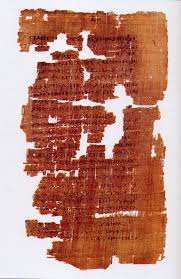
The oldest false narrative concerning the childhood of Jesus is the Protoevangelium-Gospel of James. It was anonymously written c.150 AD. It expanded on the birth story and focuses heavily on the life of Mary. It was during this time period that a cult began to grow within the early Catholic Church concerning Mary. While many Church Fathers condemned this deification of Mary, there were political pressures being put on the Church to create doctrines that would encourage pagans to convert to the only state authorized religion. Please see related: “Christianity Versus the Catholic Church”. This book was the first to publicly declare that Mary remained a perpetual virgin after the birth of Jesus, and that she should now be considered the Mother of God and Queen of Heaven. The author was aware that there was a growing movement within the early Church female population that Mary, the mother of a Godman, deserved more attention and credit than Scripture gave her. So the author apparently decided to start with the birth of Mary and invent an ongoing what if scenario.
The author wrote that Mary was immaculately conceived the same as was Jesus. The Catholic Church's official doctrine on this issue is that Mary was not miraculously conceived. This is in line with what Scripture clearly states. Instead, they say she was conceived in a "special way" but have never issued a statement clarifying the word "special". From the age of three, she was raised in the Temple even though Jewish law does not allow this. At age twelve, the High Priest was passing an elderly Joseph when a dove flew out of his staff. The High Priest took this as a sign that Joseph was to be Mary's husband. There is no record of this Temple miracle in any Jewish writing. On the way to Bethlehem, Joseph placed Mary in a cave and looked for a midwife. The Gospels state Jesus was born in Bethlehem. When they returned, Jesus had been born but it was a non-physical birth. The Catholic Church states that Jesus passed through Mary like a ray of sunshine through a pane of glass. The Gospels state that Jesus' birth was normal. The midwife examined Mary, saw she was still a virgin, then the hand she used to examine Mary painfully withered. An angel appeared and told her to touch Jesus. She did as she was told and immediately the hand returned back to normal. The Gospels do not mention a midwife as being present at the birth of Jesus. The Gospel of James goes on to state that Mary did not lower herself to have other children after having given birth to God incarnate. The Gospels state she and Joseph did not have sex until after Jesus was born. It also states Mary remained a perpetual virgin. The Gospels actually name five half bother of Jesus and at least two sisters. The Church adopted the perpetual virgin scenario and would later concoct the story that her other children were fathered by Joseph from an earlier marriage in which the wife died. The Gospels use the word blood siblings when referring to Jesus' half siblings. Mary went on to live a life of virtue and a missionary for Christ. The Gospels concur. At her death, she was raptured into Heaven where she sits at the right hand of Christ, and has been crowned the Mother of God and Queen of Heaven. The Gospels make no mention of Mary's life after Jesus, where she lived, exactly who took care of her nor when she died and where she was buried. Jesus appointed John to take care of her and John was the last surviving Apostle living into his mid nineties. Therefore, we might rightly assume that he took care of her with some help from her children many of whom became missionaries on behalf of Christ.
Needless to say, the cult of Mary members were very impressed with this story as it checked all the boxes and more. However, there are no other first century writings that mention any of the events in this story line. If any of these events had actually occurred, there can be no doubt that they would have been entered into the Gospel accounts. Especially by the Apostle Luke who apparently met with Mary to get the information he needed to write his infancy narrative. The book also states that the Magi saw the stars {plural} and "...they {the stars} entered the cave where Jesus was born and one stood on the head of the child". So in this account, the family is still in the cave when the Magi arrive. However, Matthew is clear that the Magi arrived six months after Jesus' birth (Matthew 2:11). Scholars surmise that the belief that Mary remained a perpetual virgin began in the early second century, and the Gospel of James was written a few years later to strengthen and profit on this and other myths.
The Infancy Gospel of Thomas is thought to have been written in the late 4th or 5th century. It supposedly covers the childhood of Jesus from ages five to twelve. It presents Jesus as a powerful yet mischievous super boy. He is both creative but vengeful. It cites him making mud sparrows then bringing them to life. Several of the events detailed in this ridiculous work of fiction are cited by Muhammad in the Koran where it states that Jesus was able to speak to the Magi while still in His manger. Just one more nail in the coffin of seeing Muhammad as a true prophet and the author of what Muslims believe to be “the most perfect book ever written". Please see Related: “Christianity Versus the Muslim Religion”. Further, Jesus is cited as an infant who commanded a palm tree to bend down so that Mary could pick its fruit, and as a five year old struck playmates blind and some cases dead only to restore them back to health. How preposterous!
The Gospel of Pseudo-Matthew is thought to have been written between 600 AD to 650 AD. The unknow author combined elements of the Infancy Gospel of James with the Infancy Gospel of Thomas. In this story, Mary gives birth in a cave on the way to Bethlehem. The Gospels are clear Jesus was born in a stable in Bethlehem. Early Church Fathers wrote that the stable was located in a shallow cave. This Gospel of Matthew also details the family’s flight into Egypt where apparently dragons and wild animals recognized the infant Jesus and worshiped Him. Need we say more?
The Syriac (Arabic) Infancy Gospel is thought to have been written in the 6th or 7th centuries, the book contains stories of the families journeys through Egypt. However, we know that the family escaped into Egypt in late December of 2 BC and returned after Herod’s death one year later in December of 1BC. So their stay was only little more than a year, thus not much time for many adventures.
The History of Joseph was written in the 6th or 7th century and details Jesus’ relationship with his dying father and Mary as, what else, a perpetual virgin.
The Gospel of Mary written in c. 150 AD details supposed visions that Mary Magdalene had of Jesus who gave her secret knowledge that she then passed on to the Apostles. This knowledge then emboldened the Apostles to spread the Gospel. This document was rejected by the early Church because, it was written to late after the ascension of Jesus, the author is unknown and its teachings differ radically from those of the four Gospels. Finally, this work is Gnostic in nature meaning spiritual salvation comes through the understanding of hidden knowledge rather than faith. Gnosticism also believes that while a human contains a Divine spark from God, that spark is encumbered by a physical body and lives in a world created by a lesser deity.
The 'Lost' Gospels
So, we can understand why these fictious pseudo-biographical and heretical works were not included with the Gospels of the New Testament. We also need to understand that these works, along with other unauthentic Gospels written hundreds of years after Jesus, are not in fact 'Lost Gospels'. They were never lost. They were known, studied, consistently considered to be works of popular fiction and so disregarded. There was never any real effort on the part of the Church to destroy these popular writings specifically designed to satisfy the curious minds of Christians. And in some cases, to take advantage of growing cult beliefs within the early Church movement. In particular, supporting the worship, veneration and authority of Mary, the Apostles and the Priesthood. Second and third century writers picked up on these initial storylines and began to write combined and expanded fictional biographies not caring if these earlier accounts were true in the first place. They were cashing in on the understanding that a rapidly growing Christian public loved reading these pseudo biographies of the lives, travels and miracles that were now being revealed. The scribes could not produce and sell copies fast enough to feed this reading frensy. Like the man said, “Show me the money!”
FACTS CONCERINING JESUS’ CONCEPTION, BIRTH & CHILDHOOD
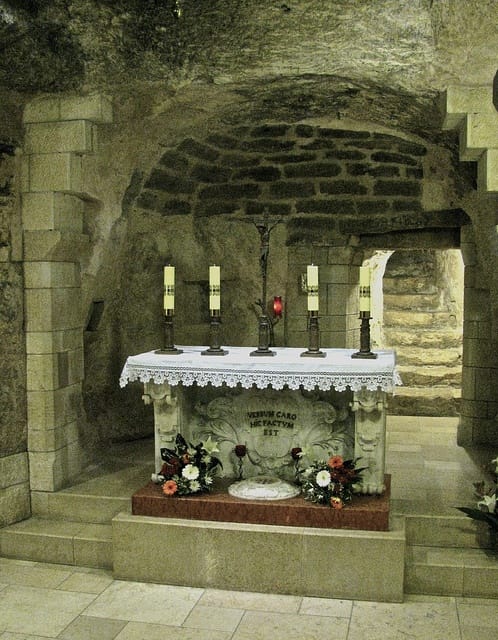
Modern archeology has shown that Joseph and Mary were childhood sweethearts living in the village of Nazareth at the end of the last century BC. We can know this as their homes have been rediscovered, excavated, accurately dated and authenticated. It should come as no surprise that their homes were venerated by Christian pilgrims before the end of the first century. Then in 325 AD Helena, the mother of Emperor Constantine and an avid Christian convert, visited these sites. She validated them by researching their history in the community, dates they were first venerated by believers and consulting with Church leaders in the area and Jerusalem. She then purchased many of the sites on behalf of the Roman Empire, and her son the Emperor had them encapsulated in cathedrals. Mary’s home is called the Church of the Immaculate Conception. Joseph’s home is called the Church of Nutrition {childhood home of Jesus}. And it turns out these two homes, partially built into the areas soft limestone, are literally across the street from each other. So Joseph and Mary grew up together in Nazareth, fell in love and married. Please see Related: “How Sacred Sites Were Discovered”.

JOSEPH AND MARY ARE MARRIED
Archeologist have uncover numerous first century headstones of Jewish women that state they were married at the age of thirteen or fourteen. In fact, the Jewish Talmud strongly suggests that the preferred date for all women to be married is thirteen. So it seems likely that Mary was in fact engaged to Joseph at thirteen or fourteen. Jewish males, on the other hand, could marry as early as thirteen, but the couple would be required to initially live in the groom’s parents’ home. According to Mosaic law, Jewish males were considered men responsible for their actions above the age of nineteen.
The traditional Jewish engagement period was one year but this was not a law. The bride was required to live with the groom’s family for a period of time to make sure the two were a good match. The bride would sleep in the groom's parents bedroom. The father of the bride would require from the groom’s father a signed agreed upon contract ketubah and present a gift to the bride’s family. The two fathers would also negotiate a Bride Price. This consisted of a certain amount of money or livestock. The bride and groom could now spend private time together without a chaperone always present. When the engagement period was over, if the two still wanted to be married, a procession took place. The bride was carried on a litter with her hair unbound to the groom’s home. There a feast was held with the couple wearing crowns and attendees singing marriage songs. The groom’s father presented the bride’s father with the agreed upon Brides Price and the bride’s guardianship was officially transferred to the groom. It was now that the couple were officially married. A ceremony involving a rabbi may occur but was not necessary under Jewish law. The two retired to the bridal chamber where the marriage was consummated. The sheet was presented to the bride’s parents for use in case the marriage ended in a divorce and there was a need to prove that the bride was a virgin before the wedding.

In the case of Joseph and Mary, the engagement period of one year was slightly truncated. According to Scripture, Mary was in her parents’ home when she was visited by the angle Gabriel. If this meeting was in fact during the three Fall feasts of Rash Hashanah, this would explain why Joseph was not present. As a healthy male, he was required by Jewish law to attend these three consecutive feasts every year in Jerusalem. Gabriel told Mary that she had been selected by God among women to give birth to the long awaited Jewish Messiah. She was also told that she would conceive through the power of the Holy Spirit and not by way of Joseph. She agreed and one may assume immediately conceived. When Joseph returned home she met with him and explained what had happened. Joseph knew by law he had three choices. He could break the engagement and send her back home to her parents. He could marry her and raise the child as his own. Lastly, by Jewish law he could accuse her of Fornication By an Engaged Virgin. This crime carried the penalty of being stoned to death on her father’s door step. After a vivid dream sent from God, Joseph immediately took her father the Brides Price and they were married. Scripture does not tell us how close they were to the full one year engagement date. But a couple always had the option to marry before the one year anniversary. So, while the sudden marriage was somewhat unusual, it would not have raised eyebrows, especially if the engagement year was to have ended in a month or two.
Mary then immediately leaves Nazareth heading south to the city of Hebron where her cousin Elizabeth lived (Luke 1:36; Luke 1:39). It would be Elizabeth who would give birth to John the Baptizer. Mary stayed with Elizabeth for three months so she most probably helped with the birth of John. She then returned back to Nazareth. Scripture is quiet about the next six months. We may assume the couple prepared a nursery for Jesus their first born male.
THE CENSUS & TAXATION & KING DAVID
However, just before Mary’s due date, Rome initiated a census that included a tax. This tax was necessary because Rome was celebrating the 750 year anniversary of its founding. There were lots of civil celebrations which required extra funding. The tax and census deadline was now approaching and Mary was due at any time. To add to this quandary, while Rome normally registered people in their place of residence, the Jewish authorities requested all Jews be required to return to their tribal capital. This way the Temple could receive an accurate updated head count on the population of each tribe and know what amount of tax the Temple should be receiving. Joseph was from the lineage of Judah a son of Jacob. This tribe was known as the Tribe of Kings with King David being the most heralded. Therefore, Joseph and Mary who were both in the lineage of King David, were both required to go to Bethlehem the capital city of the Tribe of Judah. There they would report to the Roman authorities the number of family members, real estate holdings and their tribal affiliation. Then they would pay a Head Tax, and take the standard pledge of allegiance to not conspire against Roman rule. This was all very unnerving for a distant son and daughter of a Jewish King. Jesus would be convicted of sedition and executed by Rome because He was a direct descendant of King David and told Pilate He was in fact a King.
You see, Rome long consider the Jews "the most disagreeable people they ever had the displeasure of ruling". Further, the Jews were always praying that a male child in the direct lineage of David would be born, rise up and defeat the Romans. So, Rome distrusted anyone in the royal line of King David. Further, King Herod from the illegitimate and reviled tribe of Esau, hated with a passion the royal legitimate lineage of King David. Therefore, anyone in the bloodline of David who ever spoke of an insurrection was summarily executed.
THE STAR REVEALED

Unbeknownst to Joseph, Mary and the Jewish nation, God was now about to use the heavens to announce the birth of His Only Begotten {human} Son. God said, “I will use the sun and moon and ‘stars’ to serve as signs to mark sacred times and days and years.” (Genesis 14) So, it should come as no surprise that He did just that concerning the birth of Jesus. Modern astronomy has proven that the constellations are fixed in the sky. The reason they seem to move is because the Earth is rotating around its star or sun. However, this rotation is constant and therefore the seeming movements of the stars and the actual movements of the planets can be accurately tracked and predicted. And their moments are as constant as a Swiss watch. With today’s computer driven astronomy apps, we can easily and accurately look at planetary moments thousands of years in the past and thousands of years in the future.
When we look for unusual movements in the last century BC and first century AD, we find a striking anomaly. On June 17th 2 BC, we can clearly see that Venus the planet of love and Jupiter the king planet came within two degrees of each other. To the unaided eye, this conjunction produced the brightest object ever seen in the night sky. This then was undoubtably the famed Star of Bethlehem and the date Jesus was born (Numbers 24:17-19).
JESUS BORN IN A STABLE LOCATED IN A CAVE

As Joseph and Mary made the seventy mile trip southeast to Bethlehem, her unknown due date of the 17th loomed. The couple would have traveled about ten to twelve miles per day and camped out under the night sky for the better part of a week. They would have seen the star, but Scripture does not tell us if they questioned its appearance. They probably just stared in wonder like many others not connecting it to the imminent birth of their son. Then, just as the couple entered Bethlehem, Mary’s water broke. Joseph tried to get a room at the Geruth Chimham Inn better known to locals as the Inn at Bethlehem. However, it was full of other last minute tax payers. So, he settled for the Inn’s stable located in an adjacent shallow cave. Jesus was born, the shepherds visited and the next day Joseph rented a room. He apparently found ample work in Bethlehem and decided to stay for the foreseeable future. He no doubt had tribal relations living there, and friends and family in Nazareth could visit them during the annual feast pilgrimages to Jerusalem. Bethlehem was located just four miles to the south.
The first mention of Jesus being born in a stable located in a cave is found in the work of Justin Martyr when he wrote that Jesus was born in a cave near Bethlehem. It is clear he did not know exactly where the cave was located. However, in 246 AD, Origen wrote that Jesus was born and placed in a manger located in a cave. And this cave was famous and regularly visited by pilgrims of faith (Origen, Against 1:51). This was the cave Helena the mother of Emperor Constantine bought in 324 AD and encapsulated the site in the The Church of the Nativity. While there are frequent assertions that Jesus was born in Nazareth, there is absolutely no early Christian source that supports this theory.
THE MAGI ARRIVE

The Gospel of Matthew tells us that after Jesus was born, Joseph moved the family into a house. Six months later, Joseph and Mary were surprised to see a caravan of Magi now at their door step (Matthew 2:11). Scripture tells us that the Magi, located to the east of Judah, had seen the wandering star {Venus-Jupiter} in the west appear in the constellation of Leo the 'Lion of Judah' over the land of Judah. This sight most probably reminded them of Daniel, their famous Chief of the Magi and prophet of Judah (Daniel 2:48). They would have consulted his prophecies of a World Messiah that would appear 490 years after the defensive walls of Jerusalem were rebuilt. They would have then done the math and seen that the appearance time of this Messiah had arrived. They organized and began the nine hundred mile three month journey in October of 2 BC. Over the course of the trip, they noted a rare triple retrograde of the king planet Jupiter. It had its first retrograde on October 27th 2 BC. It’s second on November 28th and its third and final one on December 25th 2 BC. It was then that, "... it {the wandering star Jupiter} stopped directly over where the child was." (Matthew.2:9)
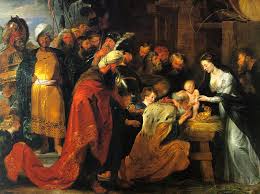
Today, modern astronomy validates these astronomical occurrences to the exact date and place. This then was the date the Magi arrived at the home of Joseph in Bethlehem. They presented gifts to Mary and Joseph making this the date of the first celebration of the birth of Christ. Joseph had a dream that night that Herod wanted to kill Jesus. So, the family immediately packed and headed sixty three miles directly south crossing the border into Egypt. The next day, Herod had all the male children under the age of two murdered. This would have been on December 29th 2 BC.
Herod’s health then experienced a massive turn for the worse due primarily to a severe case of syphilis. The bacterial infection had gone into his brain causing him to display fits similar to those of a maniacal paranoid schizophrenic. The infection also caused flesh decay to occur in his intestines. This allowed maggots to spread, literally eating him alive from the inside out. He dies in excruciating pain on December 29th 1 BC. This coincided with the one year anniversary of his command to murder the children of Bethlehem. Modern astronomy shows that there was a lunar eclipse on this date as reported by the famous Jewish historian Flavius Josephus. It was then Joseph was notified in a dream that Herod was dead. He was in the process of moving back to Bethlehem when he discovered that Herod’s tyrannical son Archelaus had been appointed ruler over a territory that included this town. So, Joseph changed course and quietly returned back to his family home in the quiet forgotten village of Nazareth. Archelaus was eventually removed from office, all his properties and possessions were confiscated by the Roman treasury, and he was banished to Spain never to return to Judah.
THE CONCEPTION DATE OF JESUS

On an interesting note, now that we know the birth date of Jesus in June of 2 BC., all we need to do is look back nine months to determine His conception date. We can now clearly see that His conception must have taken place in the Fall {September} of 3 BC. This is very notable in that this is the time of the final three annual Jewish Feasts known collectively as Rosh Hashanah. The first feast is the Feast of Trumpets or important announcements. The second is the Feast of Yom Kippur when the Jews pray for God to cover their sins and allow them to live another year. Last we have the Feast of Tabernacles or Sukkot. This feast celebrated a future time when God will once again live with mankind. What a perfect series of feasts to announce the birth of the Messiah, His ability to provide forgiveness of sin, and God incarnate was now living among mankind. Fascinating!
THE BRIEF UPDATE ON JESUS' FIRST YEARS
While Scripture is relatively silent about the early childhood years of Jesus, the Gospel of Luke tells us, "And Jesus increased in wisdom and stature, and in favor with God and Man” (Luke 2:52). This is telling us that Jesus not only grew intellectually {in wisdom}, but His demeanor garnered the respect {stature} of His community. In other words, He was seen as a very bright and obedient child under the law. The fact that He also grew in favor with God and man reflects His having a continually deepening spiritual understanding of God His biological Father and respect for the people around him. He physically developed and matured just the same as do all children, showing He was fully human. But at the same time, He also developed spiritually beyond His years which showed His Divine nature. This would suggest that while Jesus’s intellect and health were probably beyond the norm, He was not singled out by his community as being anything more or less than a kind, gifted child and a credit to His family and community.
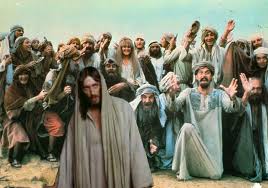
We can know this because when Jesus visited Nazareth during His ministry, He startled the village leaders. He had now obtained a reputation as a healer, He now displayed an in-depth knowledge in the Torah, He now spoke boldly and with authority, and He now intentionally left listeners with the distinct impression that He might be the long awaited Messiah. This was a dramatic behavioral change from the boy they knew, and who had quietly left the village only months earlier to become an itinerant rabbi (Matthew 13:54). Jesus had left Nazareth the humble son of a construction worker and had returned a brilliant scholar, orator, healer and followed by twelve devoted disciples. And, He was publicly intimating that the Kingdom of God had arrived in Him! They were so overwhelmed by His demeanor and startled by His prophecy that they declared Him a blasphemer. Then, hustling Him out of the synagogue, the horde attempted to throw Him off the great precipice located just outside the southern edge of the village. They would have succeeded had He not used His Divine power in some way that instantly rendered the mob harmless. He apparently passed through them to a place of safety never to return to His home village again (Luke 4:28-30). This escape is not declared a miracle in Scripture, but only that Jesus willed that He not be injured, turned and walked away from a screaming throng. Interestingly, the view from this cliff facing east, overlooks the Hill of Megiddo. It is on this plane that the armies of the world will congregate and march on Jerusalem during the War of Armageddon (Revelation 16:14-16).

JESUS HAS BROTHERS AND SISTERS
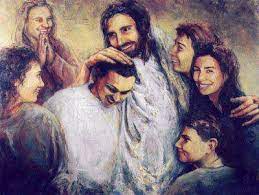
Matthew tells us that Joseph did not have sexual relations with Mary "until" Jesus was born (Matthew 1:25). This tells us that the couple did eventually start a family. We know that in the first century, seven out of ten children did not reach adulthood. Therefore it was essential that a couple try to produce as large a family as possible.
Joseph and Mary created a family and Scripture gives us the names of His brothers as James, Joses {Joseph}, Simon and Judas {Jude} (Matthew 13:55; Mark 6:3; Galatians 1:19). Scripture also tells us that Jesus had "sisters". Therefore, we may rightly assume He had a least two sisters (Matthew 13:56). And if we assume that Mary gave birth to these children in two year intervals, then by the time Jesus was twelve, He may have had as many as six siblings.
While Jesus’ sisters are not named in Scripture, ancillary sources provided by early Church Fathers tell us that one was named Mary and the other Salome. There is a third name mentioned as being Anna or Anne which is thought to have been the name of Mary’s mother.
Jesus’ siblings would eventually form a leadership group, not only because they came to believe their half-brother was the Messiah, but because Christians looked forward to hearing their first-hand stories of Jesus as a child and young adult (I Corinthians 9:5). Although none of the Gospels report this, Paul tells us that Jesus’ oldest half-brother James personally witnessed one of Jesus’ resurrection appearances that Sunday. And that it was this experience that caused him to believe on Jesus as Messiah and even head the Church in Jerusalem (I Corinthians 15:7; Galatians 1:19; Galatians 2:9; Galatians 2:12). Knowing that Jesus’ family played important leadership roles in the Judean Church during the first and second centuries, it is reasonable to assume they told stories concerning Jesus’ birth and early childhood years. Unfortunately, none of these stories were written down at this time.
JESUS GROOMED TO TAKE OVER 'JOSEPH & SONS' BUSINESS

At the age of five or six, Jesus would have begun to learn the rudiments of his father’s trade. The King James Bible states that Joseph was in Greek a 'tekton’ or “constructor”. A more accurate translation of the original Greek would be Joseph was a “skilled artisan of construction”. Perhaps in wood, stone, metal or brick, but nonetheless an experienced craftsman who made a living with his hands through the fabrication of objects or structures. Joseph would have passed down his knowledge, tools and shop to his sons. Jesus would have started off by helping His step father keep the shop clean and orderly. Then move on to assisting with building projects that took place primarily in the family’s home workshop. So the first twelve years of Jesus life were straightforward and uneventful. This was exactly what Joseph and Mary wanted, a very special child of God, in the direct line of David, that was growing up unnoticed in a remote village, under the radar of the ruling Herodian dynasty of Judah and Rome.

It was at the age of twelve that Scripture give us an update on the intellectual and social progress of Jesus. We are first told that, “His parents went to Jerusalem every year to attend the Feast of Passover.” (Luke 2:41) We may assume that Joseph and Mary took the entire family. The Jewish historian Flavius Josephus tells us that 2,700,000 Jews would make the pilgrimage to Jerusalem. This number would not include gentiles or acolytes. Passover is the first of three annual feasts that all healthy Jewish males were required to attend. Jewish boys by the age of twelve were expected to know, perhaps even have memorized, much of the first five book of the Old Testament know as the Torah. Jesus would have been taught by his father and the male religious leaders of Nazareth, who would regularly meet at the village’s synagogue. Mothers taught their daughters the Torah, but mainly focused on skills concerning planting, harvesting, cooking, weaving, household chores, the art of bartering and child rearing.
JOSEPH AND MARY MANAGE TO LOSE JESUS
Scripture tells us that Passover had ended and Jesus’ family, along with many others from Nazareth, were now packed and ready to return home. This would be a five day trip traveling an average of fifteen miles per day. It was not unusual for the children of the group to congregate and segregate themselves from their elders. This is what Joseph and Mary assumed Jesus had done as they left Jerusalem (Luke 2:42-43). However, when they camped that evening, probably in the area of Jericho, all the children were present and accounted for except Jesus (Luke 2:44). This was extremely unusual as Jesus was a very respectful and obedient child. Once it was clear that Jesus was never actually in the group of children when they left Jerusalem, Joseph and Mary hurried back to their traditional departure site assuming Jesus would be waiting there for them (Luke 2:45). The rest of their family would have continued to Nazareth the following day under the watchful eyes of relatives and friends.

Scripture tells us Joseph and Mary search Jerusalem for three days and were now frantic. After all, the angel had told Mary that Jesus was the Son of God and would reign over the House of Jacob forever. And now they had lost Him? And to make matters worse, they had lost Him literally a stone’s throw from Herod’s maniacal ruling son Archelaus? A son who no doubt remembered his father trying to kill the Magi’s “King of the Jews” only to end up dead one year later. Revenge was definitely on the mind of Herod’s son.
Eventually they decided to search the Temple. It was improbable that a twelve year old boy would be there of all places because they saw the Temple as offering nothing that would attract Him. No shops, food, street entertainers, etc. Only a cavernous, dark brooding incense filled sanctuary with old stern looking priests sitting, teaching and chanting prayers. Still they had looked everywhere else so why not there as a last resort.
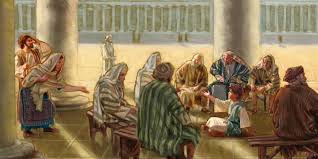
Much to their shock and dismay, they found Jesus sitting with other students in Solomon’s Portico (Luke 2:46; Acts 5:12; John 10:23). The teachers there would be giving limited free education on a variety of subjects. The portico is on the eastern side of the Temple and partially covered from the elements. It surrounds the large Temple Plaza some three football fields in size. There were chairs for teachers and rugs for those listening to sit on. Even some food and water would have been provided. People were allowed to sleep there so as to have a front row seat in the morning. There is little doubt that Jesus had camped in the safety of the Temple for the past three days.

Joseph and Mary stared incredulously as they watched their young son calmly stand in front of a group of Jewish scholars both asking and answering questions (Luke 2:47). Apparently Jesus had transfixed these religious elders with His in-depth knowledge of Scripture. This knowledge had given Him the ability to appropriately and respectfully challenge their traditional answers to age old questions with other possibilities supported by Scripture. Jesus would continue to do this throughout His ministry. Jesus was probably now seen as one of many Jewish child prodigies when it came to Scriptural study and understandings. However, His parents were very upset and confused by His aberrant behavior (Luke 2:48). Why had He knowingly ignored the families strict policy of leaving with the group for Nazareth. Why did He not tell them or at least a friend of His desire to stay. And why had he stayed in the Temple forcing them to come to Him instead of waiting at the groups exit location? So they wasted no time asking Jesus why He had upset them to the point where they actually wept during their frantic search? (Luke 2: 49).
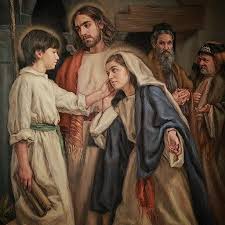
However, instead of apologizing, Jesus said to them in effect, why did it take you three days to realize I would be in the Temple accomplishing My Fathers will? In other words, the onus is on you for somehow not understanding who I am and My mission in life. You do know that I have a Divine Sonship with God the Father…right? Did not the angel make it clear to the both of you who I am? Basically He was saying to His parents, 'Pull yourselves together. This is your fault not mine!' His parents were now completely confused and did not understand what He was saying to them (Luke 2:50).
This exchange is very reminiscent of the actual Passover story. Moses goes to pharaoh and say to him, “This is what the Lord says: Israel is my first born son, and I told you, “Let My Son go, so He may worship Me.” So, the parents leave Jerusalem only to return to find their son was never lost. Instead, He was safe among the greatest scholars in the Temple asking and answering questions that challenged and amaze them. Even they had a hard time fully grasping what was going on. The student had become the teacher? And by staying in the Temple complex, Jesus had shown He was more than capable of devising a plan that allowed Him to remain safe in a strange and crowed environment. He was now exhibiting advanced survival skills. Yet at the same time, He was exhibiting both a thirst for Scriptural knowledge at the same time exhibiting an in-depth knowledge beyond that of the teachers. He was explaining to His parents that while He loved and respected them, His over riding allegiance was to the desires and expectations of His biological Devine Father. So He had, in effect, respectfully disobeyed His parent’s expectations in order to obey His Fathers expectations. However, this story ends with the phrase, “He went down {from the House of the Lord} with His parents and went to Nazareth, and was obedient to them.” And while Mary did not understand the meaning of what He had said to them, none the less, she memorized His words and eventually relayed then to the Apostle Luke (Luke 2:51).

Mary, who did not understand what was going on, none the less put this and other events to memory, a mother’s memories (Luke2:51). She would later reveal them to the Apostle Luke when He came to her as a vital source of the early life of Jesus before His ministry. Had she kept more stories like this one, she surely would have told Luke. But apparently Jesus was an obedient son who stayed out of trouble and followed the rules. Therefore we only have this one.
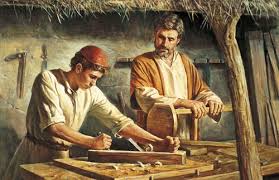
So, after reading the narrative of Luke we may rightly conclude that the childhood of Jesus, other than His one year exile in Egypt to escape Herod, was uneventful. We know that by the age of twelve He was eager to learn and question the Temple priests. He spent His early teen years as an apprentice to His step father Joseph in the family home shop as well as on various building sites. By His late teens and early twenties He would have become a skilled professional working with and without the oversite of Joseph on all building and repair projects. Jesus was seen as an honest, bright and skilled member of the community. He lived a life free from strife and controversy. However, over the forty months of His ministry, He would more than make up for lost time. In fact, He would officially become the most controversial figure in the history of mankind.
JOSEPH DIES & JESUS ASSUMES HEAD OF THE FAMILY
Because we know Joseph was alive and well when Jesus was twelve, but had died sometime before Jesus turned thirty and started His ministry, we can rightly deduce he must have died when Jesus was in His early to mid twenties.

As for Joseph serving as a father figure in Jesus' life, there can be no doubt that Jesus loved and respected him. We may rightly assume that Jesus was present when Joseph died. Jesus would have told him what to expect at death and that his intelligent spirit would live on eternally. We cannot know if He told Joseph about the coming Resurrection and Rapture events. But Judaism has always believed in a resurrection at the end of the age (John 11:23-25). So perhaps Jesus eased his fears by reassuring him of this event. Jesus no doubt told Joseph that God was happy with him and that he had a great reward awaiting him due to his immediate obedience to the commands he received from God. As to whether Jesus could have saved Joseph from death is up for debate. One would imagine that as Joseph lay dying, he may have broached this subject with Jesus. While Jesus no doubt prayed for Joseph, He would have left it in God's hands as to whether Joseph would recover and live additional years or die.
Bioarcheology shows that in first century Judah, the poor and farmers died between the ages of twenty and forty. Those who had regular access to nutritious food lived to between the ages of fifty and sixty. So, if Joseph was nineteen or twenty when Jesus was born, and Jesus was now in His late twenties, Joseph would have been approaching fifty. And it appears that at this time, while Jesus was gifted in many ways, He was not fully indwelled by the Holy Spirit. This would not occur until He was Baptized by John at the age of thirty (John 1: 32-43). It was several months after His baptism that He is cited in Scripture as performing His first miracle during a wedding in the village of Cana (John 2:7-11). So, while Joseph may have talked with Jesus and Jesus prayed for him, in reality Joseph had lived a relatively long full life. He was married to a loving wife, fathered a large healthy family, was successfully self employed, and had raised the future Messiah of Judah. So he no doubt considered his life a success, and accepted the inevitability that he had reached the age when most men died.
Jesus, as the first born son, would have inherited a double portion of his father’s estate as was Jewish tradition. As the head of the family or Nasi, He would now assume the responsible of caring for his mother and siblings. This would include making sure His sisters were well married. We can know His position in the family as he told John from the cross that he was now responsible for the care for His mother (John 19:26). Then, at the age of thirty and the start of His ministry, He would have turned the head of the family title and ownership of the shop over to James who was Joseph's biological first born son. Jesus did this for three reasons. First, He knew that His ministry would now begin and there would be no time for Him to deal with day to day family issues and business. Second, He knew that His doctrine would be one in which all His followers were to be as brothers and sisters to one another. Therefore, His mother and siblings were no more or less important to Him than His disciples and followers (Mark 3:31-35). And last but not least, He knew He was born to self sacrifice Himself for the sins of mankind.

Jesus did care for His family and, as the first born son, would probably have provided for some of their necessities by way of donations He was given to help support His ministry and those in need (John 12:6). The Gospels tell us that His family always recognized Him as the Messiah. However, some were disappointed that He did not regularly perform miracles in front of the religious leaders in Jerusalem as proof of His Messiahship (John 7:2-4).
After Jesus performed His first public miracle in Canna, He took His family to stay with Him in Peter's home in Capernaum (John 2:12). There they spent several days together. Then Jesus walked with them south towards Jerusalem. At the fork in the road, they went southwest back to Nazareth, and He traveled southeast to Jerusalem and attended the first Passover of His ministry.
JESUS PREFERS THE GALILEE REGION
When Jesus officially left His home in Nazareth at the age of thirty, He immediately went to find John the Baptizer. John would become the last Old Testament prophet. Jesus was baptized by John, went into the wilderness to locate and confront Satan then settled in the city of Capernaum. From there He would become an itinerant rabbi mainly preaching in villages and towns throughout the Upper and Lower regions of the Galilee. He would exclusively preach and teach in the Galilee the first two years of His ministry. Perhaps this was because major international trade routes ran through this area. Therefore, when Jesus taught and healed in this region, witnesses would in turn spread His notoriety outside of Judah. So His reptation increased, while at the same time, not upsetting the religious leaders in Jerusalem (Matthew 9:26, 31). This system also fulfilled a prophecy by the prophet Isaiah (Isaiah 9:1-7; Isaiah 66:19). However, when Jesus traveled to Jerusalem to attend the required annual feasts, He preached and healed in Judea as well as Samaria located south of the Sea of Galilee. During the last year of His ministry, He began to spend more and more time preaching and healing in the Judea and Jerusalem areas. This in turn cause the Temple's Chief Priests to develop a plan to have Him murdered (Matthew 26:4; John 12:10).
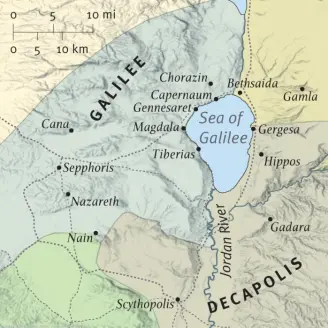
The Galilee region was forty five miles in length, thirty miles across with the Sea of Galilee as its eastern border. This land was not bucolic, peaceful, quiet with lush green rolling fields as far as the eye could see. Nor were its inhabitants well fed, clean and the gentle sheep herders as depicted in Sunday school classes. The Galilee was densely populated with 204 villages and cities. Even small villages had populations of at least fifteen thousand with a total area population of more than three million. The people endured terrible poverty and high taxation by Herod's son Antipas. Josephus describes the Galileans as a tough and courageous people, well trained in the art of war, and prone to revolt. He himself recruited 60,000 men and an infantry of 100,000 men in the war against Rome 67-68 AD. This is why Jesus spent most of His ministry in the Galilee. He was among family and friends as well as safe from Herod’s ruling sons and Rome.
THE LAST AUTHENACATED TRACES OF THE FAMILY OF JESUS
There is not a single mention nor even a hint in the New Testament that Jesus married nor that he had any children. Therefore, His half brothers and sisters were the only people genetically connected to Him by way of their common mother Mary. We read that Jesus' family became staunch founding members of His church and some became missionaries. By the middle of the first century, it was Christian doctrine that all followers of Jesus were to support one another and especially missionaries with food and hospitality (I Corinthians 9:14; II Corinthians 11:8). Many missionaries traveled the land of Judah as husband and wife teams such as Clopas and Mary who were Jesus' uncle, and aunt along with Andronicus and Junia (Romans 16:7). Paul commented that both the Apostles and missionaries had the support of their wives and often took them on their travels. He referred to these women as "sister-wives"(I Corinthians 9:5). Jesus' brothers Joses {Joseph}, Simon and Jude {Judas} were know as 'famous' missionaries during their lifetimes. James, the eldest son of Joseph and Mary stayed in Jerusalem as head of what was considered the Mother of All the Churches. Jesus' brothers were called 'Desposyni' meaning 'those that belong to the master'. The family was noted as having made the effort to preserve their genealogy after Herod had all the public genealogy records in Jerusalem burned. He did this to silence the complaints that his birth genealogy proved he was unfit to rule Judah. An early Church Father named Julius Africanus who lived in the village of Emmaus in the early third century was the one that wrote the direct relatives of Jesus were known as 'those who belonged to the master'. He also wrote that they were one of those Jewish families who had preserved their geology after Herod had the public genealogical records burned. He reported that Jesus' family members traveled throughout Judah making clear their heritage from Abraham to King David to Jesus before preaching the Gospel. They were thus proving that Jesus was the Messiah in blood, word and deed. Jerusalem and Nazareth quickly became central centers for the dissemination of the Gospel that Jesus was the Messiah and Jesus' family were revered leaders of this movement.

James was stoned to death by the Sadducees in 62 AD. This execution was ordered by the High Priest Ananus. Flavius Josephus actually recorded his martyrdom. Simeon, the son of Clopas, now became head of the Jerusalem Church. Clopas was the brother of Joseph the step father of Jesus. Simeon remained head of the Church for forty years. He was convicted by Emperor Trajan in c.112 AD of political subversion, and because he was in the Davidic bloodline, he was executed by crucifixion. According to Church Father Hegesippus {110-180 AD}, he was 120 years old at this time. This was the age of Moses at his death and the maximum age God now allows people to live (Genesis 6:3; Deuteronomy 34:7).
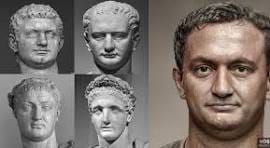
The next notation about a direct descendant from the family of Jesus concerns two grandson’s of Jude, the half brother of Jesus. They would be Jesus' great great nephews. Once again, Hegesippus wrote that the two brothers were the great grandsons of Jesus' half brother Jude. They lived during the reign of Emperor Domitian (81-96 AD). They were brought before him on suspicions that, as direct descendants and followers of Jesus, they were in the blood line of King David and preached Jesus as a King. This would be seen as a direct threat to the Emperor. However, upon closer examination, the brothers explained that the Kingdom of Jesus was spiritual and that they lived modest lives as farmers. They stated that, between the two of them they had ninety denarii {six weeks of wages each} and jointly owned about 18 acers of land that belonged to Joseph and his brother Clopas. After observing their calloused hands and sun damaged skin, Domitian agreed they were no more than two hard working peasant farmers and released them.
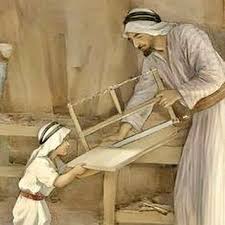
But more to the point, their story shows that the relatives of Jesus were still organized and preaching the Gospel of Jesus as Messiah. And, even more interesting, this story tells us that Joseph the step father of Jesus, was the co-owner a small farm with his brother Clopas. This meant that both families would have relied on this land to supply additional food. In particular for Joseph, Mary and their seven children. This also meant that Joseph, who needed money to purchase additional food and pay civil and Temple taxes, supplemented his income through farming, construction jobs and creating and repairing household items in a small home shop. Apparently there was never a time that Joseph was not hard at work with probably at least one child at his side assisting.
On an interesting note, by the year 350 AD, it is estimated that there were over 35 million Christians. Today there are over 2.6 billion Christians. Conversely, it is estimated that there are 16 million Jews in the world today. The question every Jew must ask themselves today is, did the High Priest Caiaphas make the right political decision for himself, but the wrong spiritual decision for his race?

Finally, records show that in 251 AD, Emperor Decius tried a man by the name of Conon who was a gardener on the imperial estate. He was found guilty of some unknown crime and executed or perhaps martyred in Pamphylia located in Asia Minor {modern Turkey}. However, at his trial he stated, "I am of the city of Nazareth in Galilee. I am of the family of Christ, whose worship I have inherited from my ancestors." Remarkably, at the entrance to one of the caves below the Church of the Annunciation {Mary's childhood home} in Nazareth, is a mosaic that bears the inscription, "Gift of Conon Deacon of Jerusalem". It is with this notation that the lineage of Jesus' family disappears into obscurity.

On a closing note. Jesus holds the number one spot for the most books published on a single person. Jesus ranks first as the Most Searched Historical Figure on Wikipedia. Jesus is consistently the most searched name on the internet. Jesus is the most highly researched religious figure in Israel. His Sermon on the Mount is universally considered the greatest sermon ever given in the history of religious literature. He is ranked as the number one most Constant Historical Figure of all time. His life is the most documented of any person in history and His name is the most Googled of any person over three hundred years old. Christianity is the largest religion in the world representing 31% of the global population. Seventy percent of Americans identify as Christian and America annually donates the most international aid in the forms of money, food and medicine than any other country in the world. Even the world's Gregorian Calendar is based on the date of His birth {actually June 17th 2 BC}. Please see related: "How the Modern Calendar Was Created".
A truly astounding record of accomplishments for a man who was born two thousand years ago in a stable, home schooled, never traveled more than one hundred miles from His place of birth, and conducted a ministry that lasted only forty months.
If you enjoy the information provided on this site, please consider making a donation of any amount to help continue its production. Donate Now